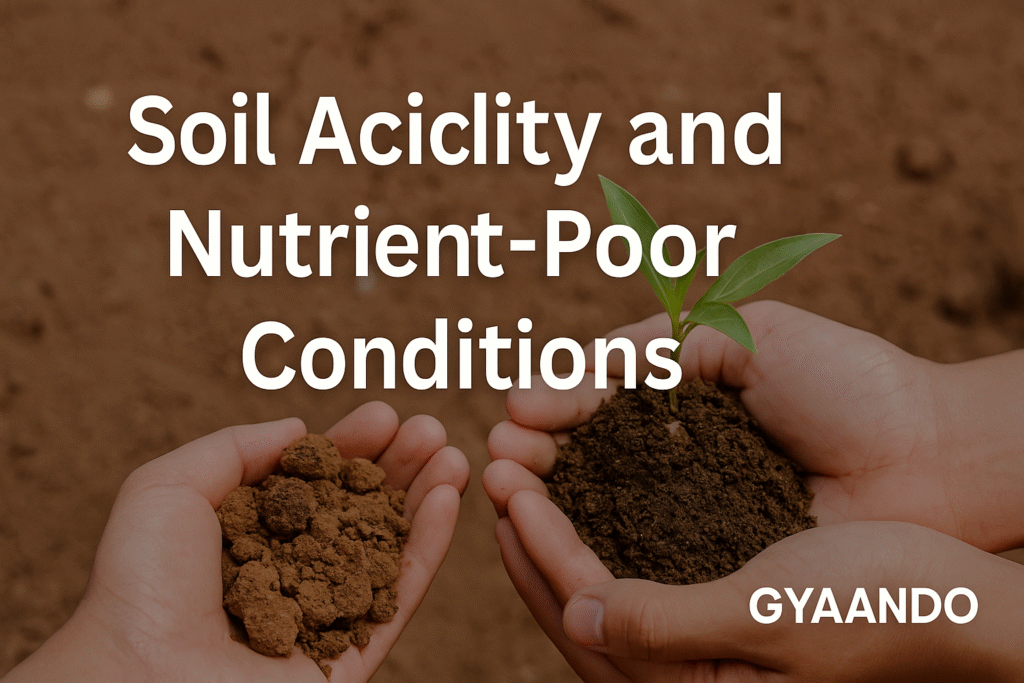Soil acidity and nutrient-poor conditions limit crop yields, stress plants, and waste fertilizer money. If your fields, garden or pots show stunted growth, yellowing leaves, poor root development or patchy yields, acidity (low pH) or a lack of essential nutrients is often the cause. This guide explains how to diagnose the problem, which amendments and management steps actually work, and how to build healthy, resilient soil for the long term
Why soil acidity and nutrient-poor conditions matter
Soil pH controls the availability of most nutrients. In strongly acidic soils (pH < 5.5) important nutrients such as phosphorus, calcium, magnesium become less available while toxic elements like aluminum and manganese can increase — harming roots. Nutrient-poor soils can be low because of low organic matter, erosion, leaching, poor fertilization, or imbalanced fertilizer use. Together these problems reduce plant vigor, increase pest problems and make yields unpredictable
How to diagnose the problem
1. Visual plant symptoms
- Yellowing between veins (chlorosis) — often iron/manganese or pH issues.
- Purpling of older leaves — may indicate phosphorus deficiency.
- Stunted roots or poor root branching — could be acidity (Al toxicity) or compacted soil.
2. Test the soil (don’t guess)
Always start with a lab or at-home soil test. A good test gives:
- Soil pH
- Organic matter %
- Available N, P, K (and often Ca, Mg, S)
- Micronutrients if requested
Local agricultural extension services offer testing and interpretation. For U.S. users check the USDA/NRCS pages; globally, FAO has helpful resources (see links at the end).
Action: Take multiple samples (zig-zag across the field) and label them.
What pH numbers mean
- pH < 5.5 — strongly acidic: many crops will struggle; aluminum toxicity possible.
- pH 5.5–6.5 — moderately acidic: many crops ok but legumes prefer 6.0–7.0.
- pH 6.5–7.5 — optimal for most crops (nutrients most available).
- pH > 7.5 — alkaline: micronutrient deficiencies (iron, zinc) may appear.
Correcting acidity
Liming — the main long-term fix
Liming raises soil pH and supplies calcium (and sometimes magnesium).
How to lime:
- Use the soil test recommendation (tons/acre or kg/ha).
- Choose the material: agricultural lime (calcitic CaCO₃) or dolomitic lime (contains Mg).
- Apply evenly and incorporate (till) if possible; liming takes weeks to months to react.
- Re-test after 3–6 months.
Tip: Finer ground lime reacts faster. Don’t over-apply — follow test results.
Quick pH adjustments
- Gypsum (calcium sulfate) helps sodic soils and supplies Ca, but it does not raise pH.
- Wood ash raises pH but is variable and can add salts — use cautiously.
- Organic materials (compost) buffer pH but won’t rapidly fix strongly acidic soils.
Improving nutrient-poor soils
Add organic matter — the single best investment
Regular additions of compost, well-rotted manure, or cover crop residues:
- Increase cation exchange capacity (CEC) so soil holds nutrients.
- Improve structure, water-holding capacity and microbial life.
- Provide slow-release nutrients and reduce leaching.
How often: Annually, and aim for at least 2–3% organic matter in cropland; higher in gardens.
Balanced fertilization — use what the soil lacks
- Base fertilizer rates on the soil test — avoid the “more is better” trap.
- Apply phosphorus where soil P is low and use banding to improve efficiency.
- Use split nitrogen applications (for many crops) to reduce losses.
Micronutrients
Soils can be deficient in zinc, boron, iron or manganese even when NPK looks ok. Soil or tissue tests will indicate deficiencies — treat with targeted foliar sprays or soil applications.
Field and cropping practices that reduce acidity and nutrient loss
Crop rotation & cover crops
- Use legumes (clover, vetch) to add nitrogen naturally.
- Deep-rooted cover crops (radish, rye) bring nutrients from depth and reduce compaction.
- Rotate cereals with legumes to balance nutrient removal.
Reduce erosion & compaction
Erosion removes topsoil rich in organic matter and nutrients. Use:
- Conservation tillage
- Contour farming and grassed waterways
- Mulching and continuous ground cover
Minimize leaching & runoff
- Match fertilizer timing with crop uptake.
- Use slow-release fertilizers or nitrification inhibitors where leaching risk is high.
Practical amendment examples & rates (general guidance)
Note: Always follow local extension recommendations or the lab report.
- Agricultural lime: typically 1–4 tons/acre (1–4 t/ha is a very rough range). Use soil test to calculate exact rate.
- Compost: 5–20 t/ha per year or 1–2 inches in garden beds.
- Rock phosphate: for long-term low-P soils; works slowly.
- Fertilizer NPK: apply according to crop need and soil test — avoid blanket high N without testing.
Monitoring & maintaining soil health
Regular testing schedule
- Test pH and nutrients every 2–3 years for established fields.
- Test annually for high-value crops or if you change management.
Keep records
Track amendments, yields, and test results so you can see trends and fine-tune inputs.
Quick checklist: first 30–90 days after diagnosis
- Get a lab soil test (pH + nutrients + OM).
- If pH < recommended range → plan liming based on test.
- Add compost or manure to boost organic matter.
- Correct specific nutrient deficiencies (e.g., P, Zn) with targeted fertilizer.
- Plant cover crop in fall/winter to protect soil and add biomass.
- Re-test seasonally or annually to measure progress.
Useful resources
- FAO — Soil Portal: https://www.fao.org/soils-portal/en/
- USDA Natural Resources Conservation Service (NRCS): https://www.nrcs.usda.gov/
(These external pages give practical background and local links for testing and recommended amendments.)
Internal reading (related posts on this site)
- For money management tips that help smallholder investments, see our finance guide: 5 Simple Money Saving Tips for Beginners in 2025.
- If you want field-tested equipment or tech for soil testing and observation, check our tech posts on smartphones & field apps like Best Smartphones Under ₹15,000 in India 2025 for affordable field photography and data logging.
Conclusion
Soil acidity and nutrient-poor conditions are common but fixable. The right approach starts with testing, then a combination of liming (when needed), regular organic matter additions, balanced fertilization and good cropping practices (cover crops, rotations, erosion control). These changes restore nutrient availability, improve soil structure and reduce long-term input costs. Begin with a proper soil test, follow the recommended amendment rates, and monitor progress — healthy soil pays back every season with better yields, lower inputs and more resilience.



